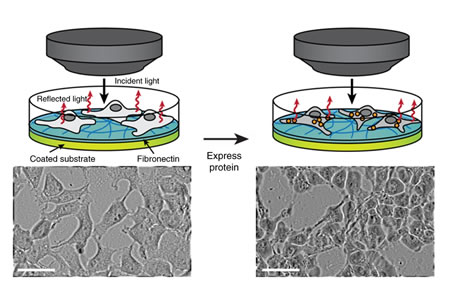Image: Chatterjee et al, Nat. Commun, 2020
Certain cephalopods have the ability to become transparent and make their cells almost invisible, the opalescent inshore squid being one example. That impressive ability can be invaluable when escaping from predators, when the ability to blend in with their environment is literally a matter of life or death.
Harnessing that ability and transferring it to human cells could be invaluable in research as it could allow living tissues to be made transparent to reveal exactly what is happening inside organs. Researchers have already turned deceased mammalian tissue transparent which has allowed tissues to be more easily visualized in 3D. Achieving this in living cells has been a major challenge.
The remarkable ability of squid comes from the arrangement of proteins in specialized cells called leucophores. These cells have reflectin proteins that are bound to membranes and present throughout the cytoplasm. The orientation of the reflectin proteins can be changed, and doing so affects how light is reflected or transmitted. In opalescent inshore squid, the arrangement of the proteins is changed using the neurotransmitter acetylcholine.
Researchers at the University of California (UCI) have made a significant breakthrough and have mimicked the ability of opalescent inshore squid in human kidney cells. Human kidney cells were genetically engineered to produce reflectin which clumped together in the cytoplasm of the cells in spherical nanostructures, which changed how light was scattered through the cells.
The researchers used quantitative phase microscopy to show how light scattering changed compared to normal human kidney cells without reflectin. In their model, sodium chloride was used as a replacement for acetylcholine to change the arrangement of the reflectin particles. The researchers were able to adjust the level of light transmitted through the cells using different levels of sodium chloride. As the concentration of sodium chloride increased, more light was scattered and the cells became more opaque.
The researchers believe their work lays the groundwork for exploring other properties of squid, such as the ability to change color patterns. These properties are hard to study in the lab due to the difficulty of culturing cephalopod cells.
“Our findings may lead to the development of unique biophotonic tools for applications in materials science and bioengineering and may also facilitate an improved understanding of a wide range of biological systems,” explained the researchers.
You can read more about the study in the paper – Cephalopod-inspired optical engineering of human cells – which was recently published in the journal Nature Communications. DOI: 10.1038/s41467-020-16151-6
